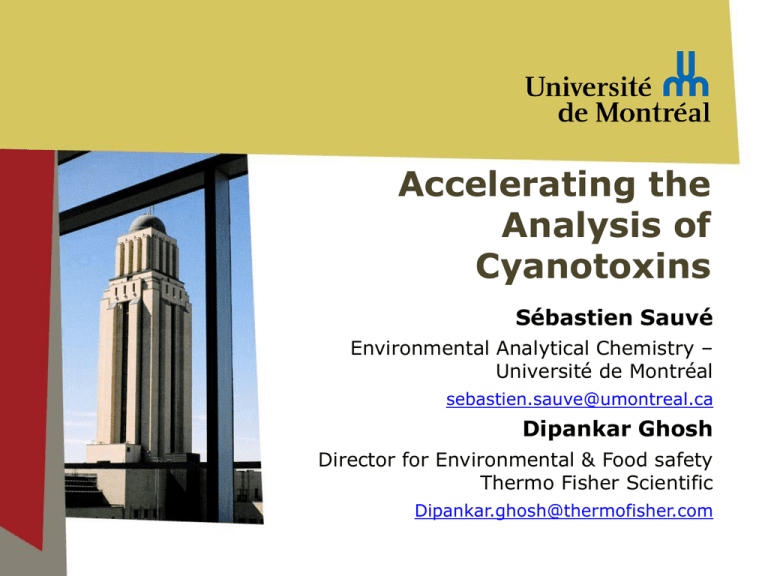
Accelerating the
Analysis of
Cyanotoxins
Sébastien Sauvé
Environmental Analytical Chemistry –
Université de Montréal
sebastien.sauve@umontreal.ca
Dipankar Ghosh
Director for Environmental & Food safety
Thermo Fisher Scientific
Dipankar.ghosh@thermofisher.com
Contributors
Audrey Roy-Lachapelle
Khadija Aboulfadl
Pascal Lemoine
Sherri Macleod
Liza Viglino
Arash Zamyadi
Michèle Prévost
Context
•Microcystins
are
hepatotoxins
produced by cyanobacteria (Bluegreen Algae)
•These cyanotoxins are found in fresh
waters and in drinking water
reservoirs.
Cyanobacterial bloom
•A bloom can occur in warm, shallow,
undisturbed surface water rich in
nutrients.
Microcystis aeruginosa
http://www.aquarius-systems.com/Entries/View/349/bluegreen_algae.aspx
http://www.plingfactory.de/index.html
K.Sivonen, G. Jones, in: 1. Chorus, J. Bartram (Eds.), Toxic Cyanobacteria in Water: A Guide to their
Public Health Consequences, London, 1999.
Objectives
•Multi-toxin online SPE-LC-MS/MS method
•Ultrafast laser diode thermal desorption
methods (LDTD-APCI-MS/MS)
•Anatoxin-A
•Sum of microcystins
Online SPELC-MS/MS
high
pressure
multi-toxins
method
Sébastien Sauvé, Département de chimie
SPE: Enrichmment
(solid phase extraction)
Automated SPE Extraction
(Online SPE)
1.0 ml
SPE
Waste
Chromatography
MS/MS
The whole mass of analytes
within the 1.0 ml sample
will ne injected into the MS
detector
LC-MS/MS
Detection:
Tandem mass
spectrometry
(selected reaction
monitoring - SRM)
ThermoElectron TSQ Quantum Ultra
EQuan MAX System
Tandem Mass Spectrometry (MS/MS)
Argon-induced Fragmentation
O
NH2
S
O
m/z=156.0
O
N
NH2
NH2
H N H
S O
O
Sulfamethoxazole+H+
m/z= 254.0
O
m/z=108.0
N
m/z=92.0
Cyanotoxins using LC-MS/MS
Challenge is to combine varied compounds into a single method for
the simultaneous determination of different cyanotoxins.
Target compounds
Compound
pKa
Molecular Weight (g mol-1)
Cylindrospermopsin
8.8
415
Anatoxin-a
9.4
165
Phenylalanine (interferent)
1.83
165
9.13
Seven microcystin
Nodularin
825
M-RR
3.5
1038
M-YR
3.5
1045
M-LR
3.5
995
Dm-LR
981
M-LY
1002
M-LW
1025
M-LF
986
Challenge
Speed!!
•Eliminate off line SPE
•Separate phenylanaline from
anatoxin a (same SRM)
http://fav.me/dsk92w
Anatoxine-a and phenylalanin
•Separation of isobars
using chromatography
C:\Documents and Settings\...\anaphe3
2010-01-29 15:05:23
RT: 0.00 - 5.00
400000
Intensity
•Quantification of specific
fragment for anatoxin-a
(166.10 > 43.3)
200000
0
3000000
2000000
anatoxine-a
166.10 > 43.3
quantification
phénylalanine
166.10 > 120.0
1000000
0
1500000
1000000
anatoxine-a
166.10 > 131.1
500000
0
1000000
500000
0
0.0
anatoxine-a
166.10 > 149.1
0.5
1.0
1.5
2.0
2.5
Time (min)
3.0
3.5
Specific conditions for cyanotoxin determinations
Chromatograms obtained using SPEUPLC/MSMS-ESI, in Milli-Q water spiked
@ 1 µg/l
Chromatograms obtained using SPEUPLC/MSMS-ESI, in real sample (lab
culture)
TR: 1.81
TR: 1.67
TR: 3.63
TR: 3.63
TR: 3.42
TR: 3.42
TR: 3.98
TR: 3.98
TR: 5.31
TR: 5.31
TR: 3.95
TR: 3.95
TR: 3.63
TR: 5.10
TR: 5.29
TR: 3.83
TR: 5.10
TR: 3.63
Preliminary estimates of
performance
Toxin
Parent
Fragment Recovery R2
cylindrospermopsin
anatoxin-a
MC-RR
MC-YR
nodularin
MC-LR
dm-MC-LR
MC-LY
MC-LW
MC-LF
416.10
166.10
519.76
1045.60
825.39
995.65
981.60
1002.65
1025.67
986.63
194.10
149.10
135.00
135.20
135.20
134.80
135.00
135.15
891.40
213.11
98
10
56
96
n/a
109
106
138
140
138
0.9913
0.9949
0.9989
0.9997
Slope
(x10-4)
5.5
8.6
104.4
2.5
0.9936
0.9933
0.9984
0.9982
0.9911
5.7
8.8
2.0
3.1
2.6
MDL
(ng/L)
0.2
10
.01
17
1
3
9
1
Even faster?
•LDTD
Laser diode thermal desorption
(LDTD)
Principles of the LDTD-APCI source:
technique that combines thermal desorption (laser diode) and APCI
sample is spotted (1-10 μL) into a 96-well plate and air-dried for 2 min
uncharged analytes are thermally desorbed into the gas phase
ionization takes place in the corona discharge region by APCI and the charged
molecules will be transferred to the MS inlet
Primary ion formation
→ e- + N2 → N2+. + 2eSecondary ion formation
→ N2+. + H2O → N2 + H2O+.
→ H2O+. + H2O → H3O+ + HO.
Proton transfer
→ H3O+ + M → (M+H)+ + H2O
Source: www.chm.bris.ac.uk/ms/theory/apci-ionisation.html
Laser diode thermal desorption
(LDTD)
LDTD
(980 nm, 20 W)
IR Laser
Installation
Can ramp up to 3000oC/sec.
Laser power is defined in %
Normally ~100-150oC
Corona needle position
(APCI)
Laser diode thermal desorption
(LDTD)
LDTD
Process
(2)
(5)
(1)
(3)
(4)
(1) Infrared laser (980 nm, 20W)
(2) LazWell Plate (96 wells): analyte desorption (1-10 µL spotted)
(3) Transfer tube transporting the neutrally desorded analytes to the APCI region
(4) Corona needle discharge region (APCI)
(5) MS inlet
LDTD Optimization
No need to optimize liquid chromatography - it has been completely eliminated!
Optimization for MS (precursor) and MS/MS (SRM transitions) conditions in NI and
PI mode.
A minimum of 2 SRM transitions were selected + their ion ratios
Parameters of the LDTD-APCI source are optimized for signal intensity :
solvent
choice for analyte deposition in the well cavities
laser power (%)
carrier gas flow rate (L/min)
mass deposition (deposition volume in µL) into plate well
laser pattern
Results / challenge
Only anatoxin-a can
be vaprized and
ionized by LDTDAPCI.
166.03>149.06
Interference from
phénylalanine:
Different desorption
patern (signal
intensity vs laser
power).
SRM Optimisation
(main SRM identical).
166.06>149.02
1.2E+07
3.1E+05
8.0E+06
2.1E+05
4.0E+06
1.1E+05
PHE Peak Area
ANA-a Peak Area
Separation using a gradient of
LDTD laser power
ANA-a
PHE
0.0E+00
1.0E+04
0
10
20
30
Laser Power (%)
40
50
60
Performances (anatoxin-a)
Calibration
2
R
type
1
Linearity
range
(µg/L)
Standards
MDL
MLQ
Avg. RSD
(µg/L)
(µg/L)
(%)
External
0.999
3 – 250
1
3
8
Internal
0.998
5 – 250
1
4
5
Microcystins
Adda
MMPB
Leucine (L)
Microcystin-LR
Arginine (R)
• The are over 80 known microcystins.
• A unique structural feature: Adda (3-amino-9-methoxy-2,6,8trimethyl-10-phenyldeca-4,6-dienoic acid) which plays an
important role in its toxicity.
X. Wu, C. Wang, B. Xiao, Y. Wang, N. Zheng, J. Liu. Analytical Chimica Acta, 709 (2012) 66-72.
Context
• The presence of microcystins can pose an health
risk for humans and animals:
–Skin irritation, vomiting, diarrhea,
headache, fever, and muscle weakness.
asthma,
–Inhibiting protein phosphatases in tissues,
causing serious damage to the liver from
bioaccumulation.
The World Health Organisation (WHO)
recomends a guideline for MC-LR of 1
mg lL-1 in drinking water.
K.Sivonen, G. Jones, in: 1. Chorus, J. Bartram (Eds.), Toxic Cyanobacteria in Water: A Guide to their
Public Health Consequences, London, 1999.
Alternatives
Need of robust detection methods to evaluate and control
the risks due to the presence of microcystins in water.
Analytical Methods
Advantages
Disadvantages
• Specific analysis
• Time consuming
• Stantards limitation
• Expensive
GC-MS
• Total MC analysis
• More steps (need
of derivatization)
• Time consuming
ELISA
• Fast and easy
• Unexpensive
• Total MC analysis
• Binding constants
of the MC with the
anti-body may vary
• Cross-selectivity
HPLC-UV
HPLC-MS
D.O. Mountfort, P. Holland, J. Sprosen. Toxicon 45 (2005) 199-206
K. Kaya, T. Sano. Analytica Chimica Acta 386 (1999) 107-112.
Objective
• Objective: Analysis of total microcystins using
LDTD-APCI-MS/MS technology.
• The method provides:
–Instant information about risks of contamination
–Information about the whole spectrum of
cyanobacterial peptide toxins congeners
Oxydation
Experimental workflow:
–Lemieux oxidation of microcystins into MMPB
–Liquid-liquid extraction (Ethyl acetate)
–Desorption by LDTD
–Negative ionisation by APCI
–Detection with a TSQ Quantum Ultra AM triple quadrupole mass
spectrometer
erythro-2-Methyl-3-methoxy-4-phenylbutyric Acid
MMPB
X. Wu, C. Wang, B. Xiao, Y. Wang, N. Zheng, J. Liu. Analytical Chimica Acta, 709 (2012) 66-72.
M-R. Neffling, E. Lance, J. Meriluoto. Environmental Pollution, 158 (2012) 948-952
Lemieux oxidation
Adda
KMnO4 + NaIO4
Microcystin
MMPB
• 0,05 M Potassium permanganate (KMnO4) and 0,05 M Sodium periodate (NaIO4)
• Oxidation, at room temperature and pH 9 for 1 hour
• Reaction quenched with saturated sodium bisulfite
• Use of sulfuric acid 10% to reach pH 2
T. Sano, K. Nohara, F. Shiraishi, K. Kaya. J. Environ. Anal. Chem., 49 (1992) 163-170.
Microcystins Oxidation Optimisation
MMPB Peak Area (arbitrary unit)
Reagents concentrations
2,5E+04
2,0E+04
1,5E+04
1,0E+04
5,0E+03
0,0E+00
0,01 M
0,02 M
0,05 M
Reagents Concentration
KMnO4 and NaIO4 optimised at 0,05 M
0,1 M
Microcystins Oxidation Optimisation
MMPB Peak Area (arbitrary unit)
Oxidation time
4,5E+04
4,0E+04
3,5E+04
3,0E+04
2,5E+04
2,0E+04
1,5E+04
1,0E+04
5,0E+03
0,0E+00
0
1
2
3
Oxidation time (h)
Optimal oxidation time at 1h
4
5
6
LDTD parameter optimisation
Laser power
MMPB Peak Area (arbitrary unit)
Best laser power at 35%
3,5E+05
3,0E+05
2,5E+05
2,0E+05
1,5E+05
1,0E+05
5,0E+04
0,0E+00
0
10
20
30
40
Laser Power (%)
50
60
70
Microcystins Oxidation Optimisation
MMPB Peak Area (arbitrary unit)
pH during oxidation
Optimised conditions at pH 9
3,5E+04
3,0E+04
2,5E+04
2,0E+04
1,5E+04
1,0E+04
5,0E+03
0,0E+00
1
3
5
7
pH
9
11
Microcystin detection and quantification
Quantification of MMPB by internal calibration with 4-phenylbutyric acid
APCI (-)
Scan time: 0,005 s
Q1 width: 0,70 amu
Q3 width: 0,70 amu
MMPB
4-phenylbutyric acid (4-PB)
(Internal standard)
Optimal Selected Reaction Monitoring (SRM) parameters for the analysis of
MMPB and 4-PB by MS/MS
Compound
MMPB
4-PB
Precursor ion
(m/z)
Product ion
(m/z)
Collision energy
(V)
131*
- 15
207.1
Tube Lens
(V)
- 25
175
- 13
91*
- 16
163.1
- 22
119
- 12
Analysis of MMPB with LDTD-APCI-MS/MS
Internal Calibration (MMPB / 4-PB ratio)
Peak Area Ratio (arbitrary units)
60
Method Validation
50
40
30
y = 0,101x - 0,0493
R² = 0,99947
20
10
0
0
50
100
150
200
250
300
350
400
450
500
n=6
R2 : 0,9995
Linearity range: 1 – 500 mg/L
LOD: 1 mg/L
LOQ: 3 mg/L
Standards Avg. RSD < 9%
Concentration (mg/L)
Calibration curve showing the linearity of the LDTD experiment
Oxidation reaction yield of Microcystins : 111%
MMPB recovery yield : 48%
WHO Guideline: 1mg/L
Conclusions
• An 8-min automated online SPE-LC-MS/MS
method for many toxins (but excluding
saxitoxins)
•Ultrafast laser diode thermal desorption
methods (LDTD-APCI-MS/MS) (15 sec per
sample but with simple oxydation for MC)
•Anatoxin-A
•Sum of microcystins
Acknowledgements
Parterns and funding agencies:
Questions?
Dipankar.ghosh@thermofisher.com
sebastien.sauve@umontreal.ca
Analysis with LDTD-APCI-MS/MS
LDTD Source
(0,5-3 L/min)
(980 nm, 20 W)
http://ldtd.phytronix.com/
déposition (petit volum
Analysis with LDTD-APCI-MS/MS
analytes neutres désorb
LDTD Source
LDTD a sample introduction method
using thermal desorption
aiguille
décharge
coro
10-plateàsample
loader
gaz (air) assure le transf
Éc
–Minimal sample preparation
960
–Small volume of sample needed (1-5 mL)
–15 sec / sample (no chromatographic
separation)
–No carryover
10 plates in the
loader = 960
samples
–Combined with atmospheric ionisation
(APCI)
–High-thoughput
http://ldtd.phytronix.com/
LazWell sample plate
LDTD parameter optimisation
Laser desorption parameters
Laser Power: 35%
Gas Flow: 3 L/min
Deposition volume: 2mL
Laser pattern duration: 6 s
GazFlow2-3 - TIC - RT: 0,00 - 0,15 NL: 4,55E5
F: - c APCI SRM ms2 207,100@cid12,00 [ 130,600-131,600]
RT: 0,07
100
95
50
90
85
80
75
70
30
65
Relative Intensity
Laser Power (%)
40
20
10
60
55
50
45
40
35
30
0
25
0
1
2
3
4
Time (s)
5
6
7
20
15
10
5
0,02
Laser pattern
0,03
0,04
0,14
0,05
0,14
0
0,02
0,04
0,06
0,08
Time (min)
LDTD peak shape
0,10
0,12
0,14
LDTD parameter optimisation
Ethyl Acetate is the best deposition solvent
MMPB Peak Area (arbitrary unit)
Deposition solvent
Plate well
5,0E+05
4,5E+05
4,0E+05
3,5E+05
3,0E+05
2,5E+05
2,0E+05
1,5E+05
1,0E+05
5,0E+04
0,0E+00
Sample residue
Ethyl Acetate
Acetonitril
Acetonitril :
Water (2:1)
Methanol
Methanol :
Water (2:1)
4,5E+05
MMPB Peak Area (arbitrary unit)
4,0E+05
Carrier gas flow rate
3,5E+05
3,0E+05
2,5E+05
2,0E+05
Gaz flow at 3,0 L/min
1,5E+05
1,0E+05
5,0E+04
0,0E+00
2,0
2,5
Gaz Flow (L/min)
3,0











